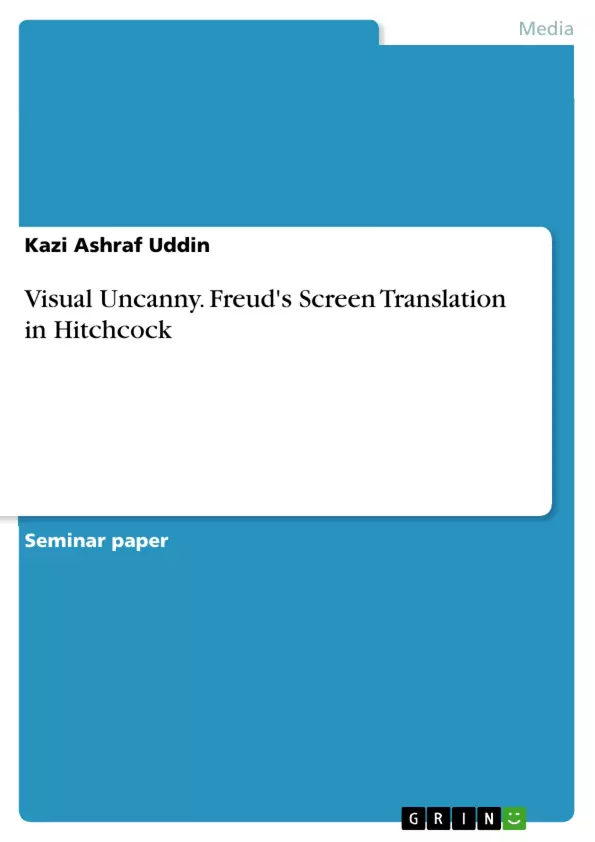“Uncanny” as a recurrent gothic ingredient has been pervading the literary narratives for quite a long time since the period of The Castle of Otranto and Mysteries of Udolpho. The idea of the “return of the repressed” dominates the concept the “uncanny” which Sigmund Freud elaborated in his 1919 essay “The “Uncanny””. However, this unfamiliarity of the real is something which grounded the domain of suspense in the prose narratives and helped in rendering the text a creepy sentimentality. But it should be kept in mind that this feeling is nothing alien to our emotional praxis. Rather, it derives or finds its root from the mundaneness of our life. Maybe, such concern influenced Freud to theorize dream and propound the idea of “dream thought” and “dream content”.
The concept of “uncanny” is related in many ways to the concept of “return”, be it a memory, an unhappy recollection or a traumatic revisitation. Such “return” definitely accounts for a psychological interpretation with probable reference to “hauntology” and unconscious. One thing has to be clarified at this point of our discussion about “uncanny, that is, this phenomenon should be distinguished from “magic realism” which rather problematizes the reality and our familiarity with the reality. But in the context of “uncanny”, the reality should be recognized as an expression of the unconscious.
The translation of textual “uncanny” is something which deals with the visual physicality of the objects. The “uncanny” what we perceive through words is quite different from what is spelt out by means of visuals and sound. The elaboration of popular culture and the invention of cinema technologies have facilitated and innovated a new mode of presentation of the “uncanny”, that is film. Film as a new sign system can different modes of presentation to render the familiar unfamiliar ranging from shots, set-design, settings to sound cuts. As “uncanny” became the key supplement to gothic literature, so gothic films (generic term for horror movies) inculcate the depiction of the so-called unfamiliar (the unheimlich). Film plays, as Lesely Stern argues, with “indeterminacies: here/there, appearance/disappearance, life/death, past/future [...]” thus knocking our “imagination, our unconscious, to produce a sensory affect of dissonance at the very moment of identity.” The fluctuation between such indeterminacies is what renders the “uncanny” possible and helps question our own senses. [...]
Inhaltsverzeichnis (Table of Contents)
- Introduction
- Uncanny Quotidian turned into Unhomely
- Vertigo – constructing the “architectural uncanny” and deconstructing the subjectivity
- Rebecca: return of the uncanny repressed
- Conclusion
Zielsetzung und Themenschwerpunkte (Objectives and Key Themes)
This paper examines the concept of the "uncanny" in Alfred Hitchcock's films Rebecca (1940) and Vertigo (1958). It explores how Hitchcock translates the mundane into the aesthetics of strangeness, transforming the familiar into the unheimlich. The paper analyzes how Hitchcock utilizes visual elements like shots, set-design, and sound cuts to create a sense of unease and suspense, drawing on Freudian psychoanalytic concepts of the unconscious, repression, and desire.
- The "uncanny" as a recurrent gothic ingredient in literature and film.
- The relationship between the "uncanny" and the "return of the repressed."
- The role of film as a visual sign system for depicting the "uncanny."
- The influence of Freudian psychoanalysis on Hitchcock's films.
- The concept of the "double" and its relationship to the "uncanny."
Zusammenfassung der Kapitel (Chapter Summaries)
The introduction provides a brief overview of the concept of the "uncanny" in gothic literature and film, highlighting its connection to Freudian psychoanalysis. It introduces the notion of the "return of the repressed" and the role of visual elements in creating a sense of the unfamiliar. The paper then focuses on the visual translation of the "uncanny" in Alfred Hitchcock's films, specifically Rebecca and Vertigo.
The chapter titled "Uncanny Quotidian turned into Unhomely" explores different interpretations of the "uncanny" within scholarship, particularly focusing on the work of Sigmund Freud and his concept of the unconscious. It discusses the influence of the "pleasure principle" on the development of the "self" and how the "uncanny" manifests as a repetition of the same thing, often connected to the loss of a physical entity.
Schlüsselwörter (Keywords)
The primary keywords and focus topics of this paper include the "uncanny," the "unheimlich," Freudian psychoanalysis, Alfred Hitchcock, film, gothic literature, visual elements, repression, desire, the "double," and the "return of the repressed."
- Quote paper
- Kazi Ashraf Uddin (Author), 2012, Visual Uncanny. Freud's Screen Translation in Hitchcock, Munich, GRIN Verlag, https://www.grin.com/document/196703



